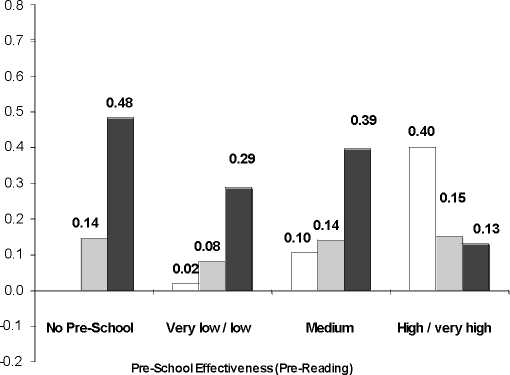effective primary school later on are still doing better than those children who did not have any
pre-school experience and went to a low effective primary school. Children who went to high
quality pre-school are doing particularly well, even if they went to a low quality primary school
later on (again indicative of a protective effect). For children who went to a high quality pre-
school centre and a medium/high effective primary school, we find an additive effect. These
children are doing best at the end of Year 5 controlling for the effect of all other background
factors. For children who had attended medium quality pre-schools there is a difference in ES for
attainment at Year 5 in Mathematics according to the effectiveness of their primary school (ES
0.50 for those in medium to high effective primaries but ES 0.33 for those in low effectiveness
primaries).
The combined impact of pre-school effectiveness and primary school
effectiveness
The combined effects of pre-school and primary school academic effectiveness were studied to
establish whether going to a more effective pre-school had a protective influence if a child went
on to a less effective primary school, and whether ‘home’ children or those who went to a less
effective pre-school centre did better later if they went to a more effective primary school.
Results for Reading and Mathematics are presented in Figure 3.10 and 3.11. The reference
group for these analyses are children with no pre-school experience who attended a low
academically effective primary school.
Figure 3.10: The combined impact of pre- and primary school effectiveness on attainment in
Reading at Year 5
The Combined Impact of Pre -School and
Primary School Effectiveness: Reading
□ Very lew / lew
□ Medium
■ High / very high
φ
N
ω

Primary School
Effectiveness
(Reading):
Reference Group: Ne Pre -Scheel and
Very lew / lew Primary Scheel Effectiveness
For Reading we find that children who did not attend any pre-school (the ‘home’ group) benefit
especially if they go to a highly academically effective primary school. Children who attended a
very low, low or medium effective pre-school centre in terms of promoting children’s Pre-reading,
benefit a lot from the academic effectiveness of the primary school for English, but there is an
additive effect, i.e. children who attended an academically highly effective primary school and a
medium effective pre-school are still showing higher attainment than children who attended a
highly effective primary school and a low effective pre-school centre.
For Reading, the patterns are particularly clear for the medium effective pre-school school group
(this can be seen as more typically representative for the majority of children and has the larger
24
More intriguing information
1. The name is absent2. PERFORMANCE PREMISES FOR HUMAN RESOURCES FROM PUBLIC HEALTH ORGANIZATIONS IN ROMANIA
3. The Making of Cultural Policy: A European Perspective
4. Human Rights Violations by the Executive: Complicity of the Judiciary in Cameroon?
5. The name is absent
6. The name is absent
7. Moffett and rhetoric
8. The Composition of Government Spending and the Real Exchange Rate
9. CONSUMER PERCEPTION ON ALTERNATIVE POULTRY
10. Økonomisk teorihistorie - Overflødig information eller brugbar ballast?